We left Waveland, MS, heading for Galveston and the weather was rainy and cool.
 |
| Crossing the Mississippi River into Louisiana. |
 |
| A Mississippi ship being loaded. |
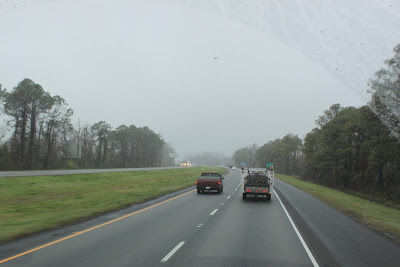 |
| Onward we drove through the gloom. |
 |
| Louisiana is called the "Wetlands State". |
 |
| Water was sitting everywhere. |
 |
| The rivers were overflowing. |
 |
| Finally, we hit the Texas state line. It was still raining. |
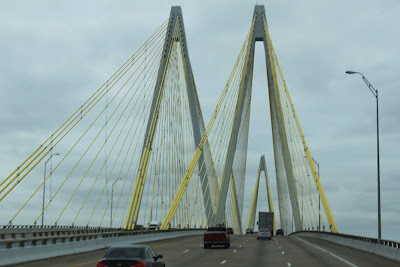 |
| Crossing a bridge near Galveston. |
 |
| Whoa.....is that a little blue sky we see as we are driving down Seawall Blvd on Galveston Island? |
 |
This may be an oil rig in the distance.
|
The next day we lucked out and finally got blue skies but the temperature was still cool and the wind was gusting to 20 miles per hour. But at least we had sun!
 |
| Hooray!!!!!! |
Galveston is a coastal city located on Galveston Island which is a barrier island off the coast of Texas. Named after Bernado de Galvez y Madrid, the Count of Galvez, it is the first European settlement on the island and was constructed around 1816. The Port of Galveston was established in 1825 by the Congress of Mexico following its independence from Spain. The port served as the main port for the Texas Navy and later as the capital of the Republic of Texas.
In the 19th century it was a major commercial center and one of the largest ports in the US. Then a hurricane hit on September 8, 1900, killing an estimated 6,000 to 8,000 people. Following the storm, a 10 mile - 17ft high seawall was built to protect the city from floods and hurricane storm surge. The plan raised much of the existing city to a sufficient elevation behind the seawall to help maintain confidence in the city but Galveston never fully recovered. To rebuild the population, the city actively solicited immigration of 10,000 Eastern European Jews from northeastern US cities. Additionally, numerous immigrants including Greek, Italian, and Russian Jews came to the city which altered the ethnic makeup of the island as well as other areas of Texas and the western US.
Competing with Houston harbor, the city diversified into tourism and banking. During the 1920s and 1930s Galveston exploited the prohibition of liquor and gambling and became known as the sin city of the Gulf.
 |
| The northeastern tip of Galveston Island has been a defense fortification since the early 1800's. The area was home to Spanish and French forts, the Republic of Texas, the Confederate Army, the Union Army, and the US Army during World Wars I and II. The last fort, Fort San Jacinto, was decommissioned in 1959. Ships in the distance in Galveston Bay. |
 |
| Standing on the spot which was the base of one of the 60mm gun placements. Do I look cold? |
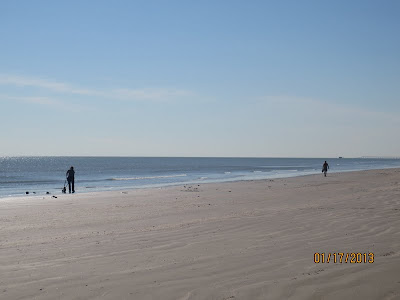 |
| The weather improved each day and we were able to walk along the Gulf with the pups. |
 |
| Seawall Blvd is the main drag along the Gulf coast in Galveston with piers that have all kinds of entertainment. |
 |
| Huge granite slabs stretching out into the Gulf are used to control the waves. One of the nice things about Galveston is that there are no buildings on the water so everyone can enjoy the ocean. |
 |
| Another tourist pier on the blvd. |
 |
| A beautiful hotel overlooking the Gulf. |
 |
In the distance you can see part of the seawall. This area is filling with sand so the wall isn't as high. Beyond the wall is the main thoroughfare, Seawall Blvd, with buildings on the other side of the street.
We visited the welcome center which was in an old Galveston mansion. This home is in the middle of Galveston Island with the Gulf eleven blocks to the east and Galveston Bay nine blocks to the west.
|
 |
| It is called Ashton Villa and was built in the 1800's. |
 |
| Notice the rectangular plaque on the right side of the door several feet high. |
 |
| Even today the island still experiences hurricane and flood damage. Imagine the damage to the buildings closer to the water. |
We toured the older district to look at some of the beautiful homes and also the tree carvings that evolved after Hurricane Katrina damaged the island. Many of the stately trees fell during the storm but a creative resident, working through the city's approval process, found three chain saw artists to create the artwork. Each homeowner chose their subject matter, and commissioned and paid for the work to be completed as a tribute to the trees lost in Galveston.
 |
| Hard to believe this was sculpted from a tree trunk. |
 |
| A stately home. |
 |
| Alongside this sculpture was information about the tree. This particular block was flooded with 5 feet of water and the homes were also heavily damaged. The heron was carved from the remaining trunk of an 80 year old live oak tree. Its roots are still in the ground. The tree will eventually rot, from the roots up, and at that time they will cut the sculpture off the base and place it on a slab. Each year a protective wood preserve is put on the sculpture. |
 |
| A squirrel with a Xmas hat on. |
 |
| The Tin Man with Toto on the left. |
 |
| One of my favorites, this tree was partially destroyed and then turned into beauty. |
 |
| The remaining branches are in perpetual bloom. |
 |
| Dressed for the Mardi Gras. |
 |
| Even the parks had tree art. |
 |
| A magnificient pelican. |
 |
| A beautifully renovated home. |
 |
| This abused looking house is in renovation with completed homes to each side. It is a common sight in the older parts of Galveston. |
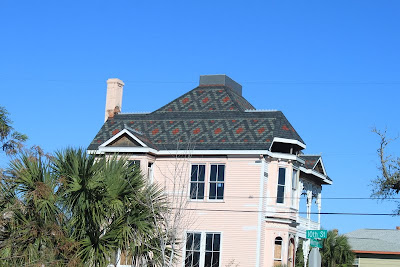 |
| Another remodeling job, the roof was unique. |
Another one of our visits was to the historic downtown Strand District. The area is full of shops and restaurants and bars and they were decorating for Mardi Gras. Kind of like a miniature Bourbon Street.
 |
| We stopped at a sidewalk cafe and had a drink. They didn't sell hard liquor so I had a glass of margarita wine. Not bad. If they hadn't told me, I would have thought I was drinking a real margarita. |
We also toured the Ocean Star Drilling Rig Museum and the following is a a ten thousand foot overview that still makes my head hurt.
 |
| The Ocean Star was built at the Bethlehem Steel Shipyard in Beaumont TX, in 1969. It is called a jack-up rig and can operate in 173 feet of water designed to drill a well to 25,000 feet. The rig drilled in the Gulf of Mexico until 1984 when it was decommissioned. This is only one of many types of rigs used today. Others are much larger and drill deeper. |
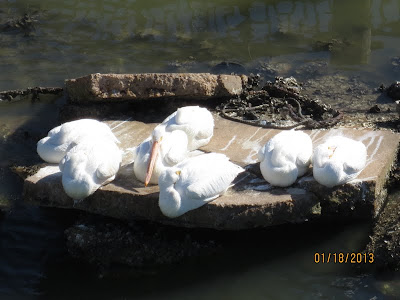 |
| Some of the current crew members taking a break. |
 |
| This is called a "Billy Pugh" basket named for its inventor. It is an efficient way to transfer personnel between the boat and the rig. Work shifts can last between seven to thirty days and the workers are transferred from the boat to the rig by lowering the basket over the side using a crane. As the boat passes the workers must quickly toss their bags into the basket and jump aboard. The crane then hoists the basket more than 100 feet and sets it safely on the deck of the rig. |
 |
| This is an ROV (remotely-operated vehicle) used to install and monitor sub-sea equipment. ROV's are used for deep water inspection of pipes as well as construction and maintenance. They allow specialists who are not expert divers to do the work from aboard ship. |
 |
| Underwater construction is also completed by divers who can descend to 2,300 feet and work for extended periods. Powerful manipulator claws and specially built automated wrenches, cutters, and grinders give divers what they need to perform hundreds of deep water installation and repair tasks. |
 |
| A dive suit up close and personal. What do you do if you have an itch? |
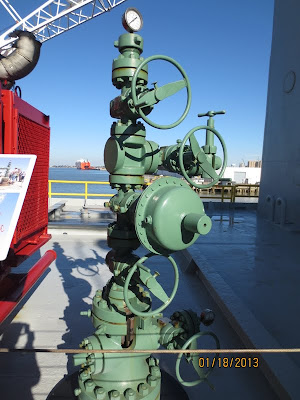 |
| This is called a christmas tree. It is an assembly of control valves, pressure gauges and chokes located above the wellhead. The valves open and close to control the flow of oil and gas. |
 |
| The hyperbaric chamber that was on the rig. The divers must lay in this for several hours after they have completed their work to allow the air bubbles absorbed in their blood to dissipate. |
 |
| This is a BOP (blow out preventer). Several of these are installed at the wellhead and can be closed against an increase in pressure. On a jack-up rig like the Ocean Star, the BOP would be installed over a large diameter casing at the surface. On deep water floating rigs, the BOP sits on the ocean floor. If you recall, the blow out protector was what failed in the Gulf of Mexico that caused the huge oil spill several years ago. |
 |
| The orange capsule is an escape pod. In the event of an emergency, it can hold 28 crew members and be lowered over the side of the rig. The crew could then move away to a safe distance and wait for rescue services. The pod is equipped with a two-way radio, safety gear, first aid supplies, water, and a cooling system that pumps seawater over the pod until the crew can be retrieved. |
 |
| The drilling area of the rig. |
 |
| A replica of a single link of the anchor chain from the spar. The chains cover an enormous area of the sea floor before finally anchoring the rig. A single link of anchor chain weighs 545 pounds and it took approximately 3,232 links of solid steel to hold the spar in place. |
 |
| On April 20, 2010, while working on an exploratory well approximately 50 miles offshore Louisiana the drilling rig, Deepwater Horizon, experienced an explosion and fire. It resulted in 11 deaths, the sinking of the rig, and ultimately the blowout and spill in the Gulf of Mexico. They are still investigating the cause of the disaster.... |
Finally, a few other pictures of the area before we move on. Galveston is a fun place and we plan on coming back this way again.
 |
| Galveston harbor. |
 |
| A barge moving through the harbor. |
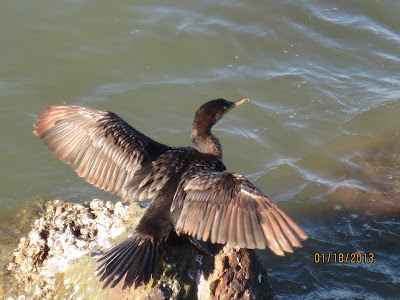 |
| Getting vibes from the sun. |
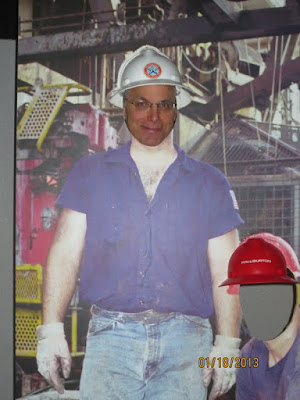 |
| My drilling man......hmmm.......not sure if that came out right. |
 |
| Another stately mansion......... |
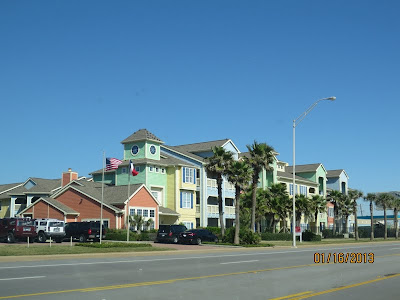 |
| ........homes with color......... |
 |
| ..........and homes to be forgotten. |
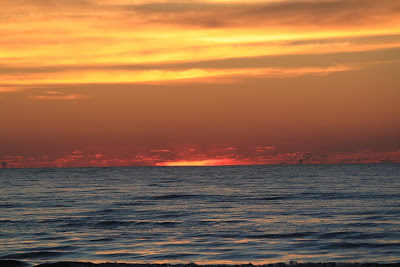 |
| As the sun rises on another beautiful day, |
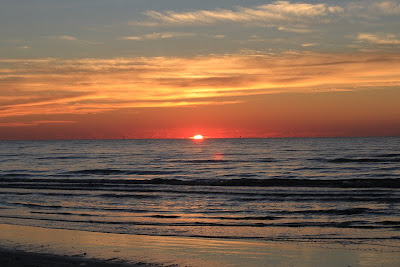 |
| we bid adieu to this peaceful scene |
 |
| and head out to our next adventure. Peace! |
